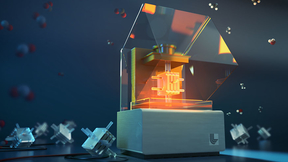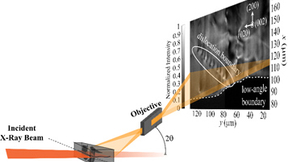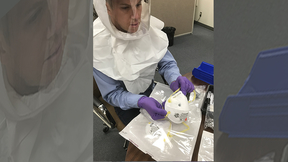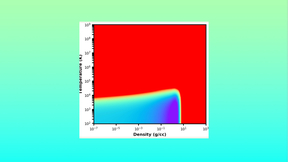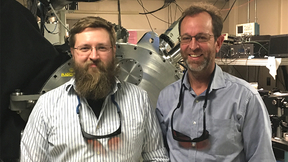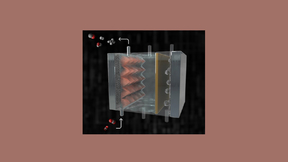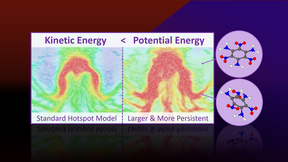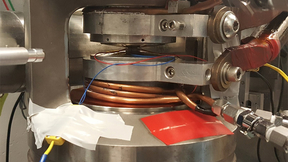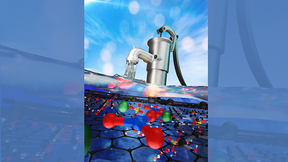Back
How could life begin from a swirling chaos? How did Earth and its moon form? What can lunar rocks from the Apollo missions reveal? And what will scientists learn from exploration on distant moons? These questions are addressed in this four-part feature article on Lawrence Livermore’s space science research.
Lawrence Livermore National Laboratory (LLNL) scientists and their collaborators are leveraging the power of 3D printing to improve the performance of electrochemical reactors used to convert carbon dioxide (CO2) to useful energy sources, chemicals and material feedstocks. Working under a cooperative research and development agreement (CRADA) with Stanford University and…
A Lawrence Livermore National Laboratory (LLNL) scientist and collaborators have demonstrated the first ever “defect microscope” that can track how populations of defects deep inside macroscopic materials move collectively. The research, appearing today in Science Advances, shows a classic example of a dislocation (line defect) boundary, then demonstrates how these same…
Inspired by the way plants absorb and distribute water and nutrients, Lawrence Livermore National Laboratory (LLNL) researchers have developed a groundbreaking method for transporting liquids and gases using 3D-printed lattice design and capillary action phenomena. In a paper published today in Nature and featured on the publication’s cover, LLNL researchers describe 3D…
Lawrence Livermore National Laboratory (LLNL) engineer Bill Pitz has earned a lifetime distinguished achievement award from the Department of Energy’s Vehicle Technologies Office (DOE VTO) for his significant contributions to the field of chemical kinetics. Pitz, along with retiree Charles Westbrook, produced a chemical kinetic study of fuel additives for engine knock in…
A long-held goal by chemists across many industries, including energy, pharmaceuticals, energetics, food additives and organic semiconductors, is to imagine the chemical structure of a new molecule and be able to predict how it will function for a desired application. In practice, this vision is difficult, often requiring extensive laboratory work to synthesize, isolate,…
Scientists at Lawrence Livermore National Laboratory (LLNL) have determined that heating N95 respirators up to 75 degrees Celsius for 30 minutes deactivates a surrogate coronavirus without compromising the device’s fit and its ability to filter airborne particles. This temperature (equivalent to 167 degrees Fahrenheit) is easily achieved in hospitals and field settings…
To address inefficiencies in transmitting electricity over smart grids, engineers at Lawrence Livermore National Laboratory (LLNL) and their collaborators have developed a light-activated switch that, if fully deployed, could reduce carbon emissions by more than 10 percent. Capable of sending high-voltage, direct-current power along grid lines and switching high voltages…
Lawrence Livermore National Laboratory (LLNL) materials scientist Bill Pitz has been selected as a 2021 SAE fellow. Established in 1977, SAE fellow status is the highest grade of membership bestowed by the organization to members from industry and academia. More than 750 individuals have earned the distinction since its implementation. “I greatly appreciate being…
Modern medicine relies on an extensive arsenal of drugs to combat deadly diseases such as pneumonia, tuberculosis, HIV-AIDS and malaria. Chemotherapy agents have prolonged lives for millions of cancer patients, and in some cases, cured the disease or turned it into a chronic condition. But getting those drugs into disease-ridden cells has remained a major challenge for…
“Sterile neutrinos” are theoretically predicted new particles that offer an intriguing possibility in the quest for understanding the dark matter in our universe. Unlike the known “active” neutrinos in the Standard Model (SM) of particle physics, these sterile neutrinos do not interact with normal matter as they move through space, making them very difficult to detect. A…
Beryllium is a lightweight, low-density material used in a wide range of applications that require stability at high temperatures and pressures. Because of beryllium’s favorable traits, it has been considered as a potential capsule material for inertial confinement fusion (ICF) applications. Hydrodynamic simulations of ICF are frequently used to model the capsule behavior…
Three years ago, scientists at the University of Michigan discovered an artificial photosynthesis device made of silicon and gallium nitride (Si/GaN) that harnesses sunlight into carbon-free hydrogen for fuel cells with twice the efficiency and stability of some previous technologies. Now, scientists at Lawrence Livermore and Lawrence Berkeley national laboratories – in…
Lawrence Livermore National Laboratory (LLNL) scientists recently published the results of a three-week experimental campaign at the Lab’s Jupiter Laser Facility to test the performance of laser-heated additive manufactured foams. The project helps support two major Laboratory focus areas, including helping to advance additive manufacturing and by enabling improvements in…
Laser powder bed fusion (LPBF) is a prominent additive manufacturing (AM) process that fuses thin layers of metal powder to underlying layers using laser melting in a sequential process. However, the high cooling rates and peak surface temperatures of the LPBF process can cause solidification defects in lightweight materials such as aluminum (Al) alloys, which have poor…
Using carbon dioxide (CO2) emissions to create value-added products is an attractive approach to reduce net greenhouse gas emissions. Processes such as the electrochemical reduction of CO2 to ethylene and ethanol offer a pathway to producing commodity chemicals without fossil fuels when they are powered using low-carbon electricity. Gas diffusion electrode (GDE) assemblies…
Research conducted on Lawrence Livermore National Laboratory’s (LLNL) supercomputer Quartz highlights findings made by scientists that reveal a missing aspect of the physics of hotspots in TATB (1,3,5-trimamino-2,4,6-trinitrobenzene) and other explosives. Hotspots are localized regions of elevated temperature that form from shock-induced collapse of microstructural…
When it comes to California implementing a carbon capture and storage program to reach the state’s goal of carbon neutrality by 2045, nothing too newfangled needs to take place. During a forum titled “Carbon Capture and Sequestration in California: Regional Insights and Community Attitudes,” a group of scientists, California policymakers and industry leaders came together…
Researchers have shown how applying pressure to a specific thermoelectric material, TiNiSn, increases its efficiency and leads to a structural phase transition. Thermoelectric materials are materials that can provide energy without the need for mechanical parts by converting heat energy into electrical energy. Thus, research aimed at these materials can identify new, more…
Livermore scientists working alongside Stanford University researchers have made headway toward a new generation of tailored, reversible water treatment.


